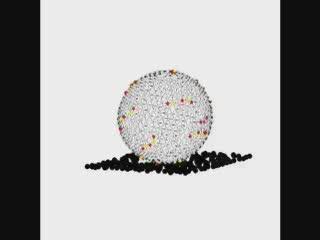Earth
A fossil which has lain in a museum drawer for over a century has been recognized by a University of Leicester geologist as a unique clue to the long-lost skills of some of the most sophisticated animal architects that have ever lived on this planet.
It has provided evidence that early organisms developed specialised roles and that these specialists displayed co-operation in order to construct their homes – much like today's builders employ a team of bricklayers, plasters and decorators.

This video shows colloidal beads (bright dots) that have assembled themselves on a liquid droplet to form a three-dimensional curved crystalline structure. The positive electric charges cause the beads to repel each other, leading them to arrange themselves naturally in a honeycomb pattern with each particle equally distant from six others.
(Photo Credit: William Irvine, University of Chicago)

AMES, Iowa – Two Iowa State University graduate students are just back from the Gulf of Maine with another big catch of clam shells.
Shelly Griffin and Madelyn Mette recently boarded a lobster boat, dropped a scallop dredge into 30 meters of ocean water and pulled up load after load of Arctica islandica.
University of Leeds-led research has used tree rings from eight cedar trees in Bolivia to unlock a 100-year history of rainfall across the Amazon basin, which contains the world's largest river system.
The new study shows that the rings in lowland tropical cedar trees provide a natural archive of data closely related to historic rainfall.
LOS ALAMOS, N.M., Oct. 1, 2012— Combine the tree-ring growth record with historic information, climate records and computer-model projections of future climate trends, and you get a grim picture for the future of trees in the southwestern United States. That's the word from a team of scientists from Los Alamos National Laboratory, the U.S. Geological Survey, University of Arizona, and several other partner organizations.
Highlights, including authors and their institutions
The following highlights summarize research papers that have been recentlypublished in Geophysical Research Letters (GRL), Journal of GeophysicalResearch - Solid Earth (JGR-B), Journal of Geophysical Research - Oceans(JGR-C), and Water Resources Research (WRR).
In this release:
1. The pros and cons of trading water: A case study in Australia
2. Linking typhoon tracks with rainfall patterns and flood timing
Alexandria, VA – The probability that a given natural hazard could become a natural disaster is higher today than at any previous point in history, largely because of population growth putting more people and infrastructure in harm's way. Who pays for the damage and how is value and risk assessed?
Much of it comes down to insurance and reinsurance agencies, which are relying more and more on sophisticated catastrophe modeling tools to help gauge when the next disaster will strike, and how much it will cost.
UPTON, NY - A Horizon Lines container ship outfitted with meteorological and atmospheric instruments installed by U.S. Department of Energy (DOE) scientists from Argonne National Laboratory and Brookhaven National Laboratory will begin taking data today for a yearlong mission aimed at improving the representation of clouds in climate models.
In the field of nanotechnology, electrically-charged particles are frequently used as tools for surface modification. Researchers at the Helmholtz-Zentrum Dresden-Rossendorf (HZDR) and the TU Vienna were at last able to reconcile important issues concerning the effects of highly charged ions on surfaces.
Changes in ocean and climate systems could lead to smaller fish, according to a new study led by fisheries scientists at the University of British Columbia.
The study, published today in the journal Nature Climate Change, provides the first-ever global projection of the potential reduction in the maximum size of fish in a warmer and less-oxygenated ocean.
Combine the tree-ring growth record with historical information, climate records, and computer-model projections of future climate trends, and you get a grim picture for the future of trees in the southwestern United States. That's the word from a team of scientists from Los Alamos National Laboratory, the U.S. Geological Survey, the University of Arizona, and other partner organizations.
SANTA CRUZ, CA--White sharks, the largest predatory sharks in the ocean, are thought of as apex predators that feed primarily on seals and sea lions. But a new study by researchers at the University of California, Santa Cruz, shows surprising variability in the dietary preferences of individual sharks.
The University of Notre Dame has received a five-year, $6.1 million award from the National Science Foundation to support the continuation of the nationwide QuarkNet program, which uses particle physics experiments to inspire students and provide valuable research, training and mentorship opportunities for high school teachers.